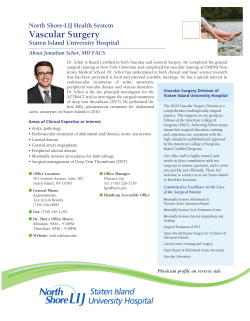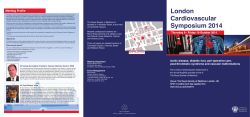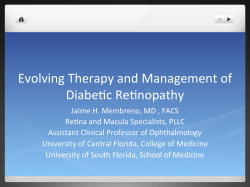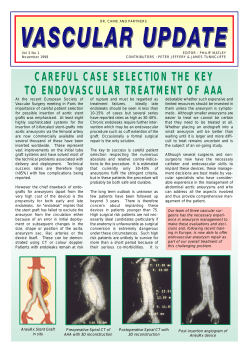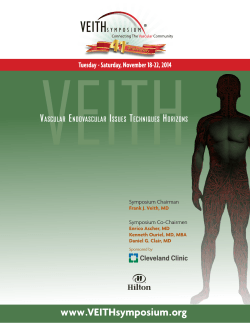
Union Européenne des Médecins Specialistes European Union of Medical Specialists
Union Européenne des Médecins Specialistes European Union of Medical Specialists Since 1958: 38 sections among which Vascular Surgery Why it is important and reasonable to get certified as a fellow of the UEMS SBVS Armando Mansilha MD, PhD, FEBVS Julian Scott MD, FRCS, FEBVS David McLain MD, FEBVS UEMS Section and Board of Vascular Surgery 1958UEMS foundation objectives - promote the highest level of patient care in the EU - promote the harmonization of high-quality training programs within the various specialities throughout the EU - facilitate the free exchange of training and work of trainees and medical specialists between the various member countries 2005Section of Vascular Surgery independent and separate Vascular Surgery in Europe Heterogeneous training, certification and recognition of independent specialism Yes No Unknown EEA country Candidate Non-member Speciality status I - Independent S - Subspeciality N - Not a speciality -VS training incorporated into GS residency - contained within GS training for selected trainees in special vascular units -VS training incorporated into cardiothoracic residency Minimum training required Country Years GS Austria Belgium Croatia Cyprus Czech Republic Denmark Finland France Germany Greece Hungary Ireland Italy The Netherlands Norway Portugal Russia Slovakia Spain Sweden Switzerland Turkey United Kingdom 6 6 4 3 2 2 3 2 3 3 6 7 1 6 5 1 2 2 1 5 6 5 1 Years VS 3 2 2 4 4 5 3 4 3 4 2 2 4 2 3 5 3 4 4 2 3 0 5 Total 9 8 6 7 6 7 6 6 6 7 8 9 5 8 8 6 5 6 5 7 9 5 6 Program accreditation and trainee certification Country Austria Belgium Croatia Cyprus Czech Republic Denmark Finland France Germany Greece Hungary Ireland Italy The Netherlands Norway Portugal Russia Slovakia Spain Sweden Switzerland Turkey United Kingdom Programs accreditted by National assoc Speciality society Government Government Government Government University Government National assoc Government Speciality society Speciality society University Speciality society National assoc National assoc Government Government Government Government Speciality society Government General Medical Council Site visit required? Yes No No No No Yes No No No No Yes Yes Yes Yes Yes Yes Yes No No Yes No Yes Yes Trainees certified by National assoc Speciality society Government Government Government Government University Speciality society Speciality society Government Speciality society Speciality society University Speciality society National assoc National assoc National assoc Speciality board Government Speciality society Speciality society Government Speciality board / JCHST Examinations required Country Written Austria Belgium Croatia Cyprus Czech Republic Denmark Finland France Germany Greece Hungary Ireland Italy The Netherlands Norway Portugal Russia Slovakia Spain Sweden Switzerland Turkey United Kingdom No No No No Yes No Yes Yes No No No No No No No Yes Yes Yes No No Yes Yes Yes Oral No Yes Yes Yes Yes No No Yes Yes Yes Yes Yes Yes Yes No Yes Yes Yes No Yes Yes Yes Yes Case load No Yes No Yes Yes Yes Yes Yes Yes Yes Yes Yes Yes Yes Yes Yes Yes Yes Yes Yes Yes Yes Yes Training in Vascular Surgery in Europe COMMENT large differences in requirements and length of training in Vascular Surgery within the EU stresses the importance of harmonization in training and certification in Vascular Surgery within the EU Current Status 1. currently a European specialist qualification in any speciality, including vascular surgery, does not replace an accreditation by the national authorities, which is the primary specialist accreditation recognized by law by all member countries 2. in countries where there is a government approved national examination, the FEBVS assessment cannot and should not be used to bypass national qualifications Thus, the European Qualification, entitling those who pass the examination as FEBVS, must be seen as a respected qualification and an European quality mark Motivation European Examination • To harmonize knowledge and skills • To indicate that the candidate has passed a structured training program • To guarantee a minimal level of competence • Promote exchange between countries by establishing a standard: FEBVS (Fellow European Board of Vascular Surgery) The Structure of the Examination Part I (Eligibility) • Certificate: CCST (*) • Logbook (endo)vascular procedures; signature / validation by supervisor • Letter from the National Vascular Society Part II (Oral) • Viva voce and technical skills assessment (*) Certificate of Completion of Specialist Training EBVS Logbook Open Vascular Procedures 80 • Basic 20 • Intermediate 40 • Advanced 20 Endovascular Procedures 50 • Basic 20 • Intermediate 20 • Advanced 10 EBVS Examination (Part II) Five parts: and 50-60 examiners 1. Clinical case analyses ( 4 cases) 2. Academic Viva; one paper 3. Overall assessment 4. Open Technical skills assessment 5. Endovascular skills assessment Clinical Examination • • • • • • • • • Examiners Briefing 4 vivas of 15 minutes each AAA Lower limb Endovascular Miscellaneous Two examiners; mark INDEPENDANTLY Fixed marking scheme 4-8 Pass mark 6 Report • The candidate was taken through the AAA case. He was extremely slow and unable to get beyond the simple questions. He required multiple prompts and was unable to recall the findings of the EVAR 1 and DREAM studies and despite the elderly patient ( 85years) having significant co morbidities and an AAA of 5.4 cms he wished to procede with EVAR. We felt that he lack insight and was unable to produce a logical management plan Report • The candidate was awful • We both felt he was useless and he would never work in my country. • Is he a doctor ?? Failure Mark Overall Knowledge and Judgement Quality of Response 4 Demonstrated incompetence in diagnosis and management Serious Concerns Did not progress beyond basic questions Very poor basic knowledge Disorganised Confused Lack of insight Prompts did not work 5 Failed to demonstrate competence in diagnosis and management Poor deductive skills Failed to apply knowledge Significant errors Poor higher order thinking Lack of understanding Disorganised answers Required frequent prompts but hesistant and indecisive Academic viva • • • • • • • Examiner pre briefing 20 minutes Paper JVS Two examiners Score system 4-8 The pass mark is 6 for each element. Overall Assessment • • • • Examiners Prebriefing 30 minutes Two assessors Questions about indications, guidelines, evidence, trials,... • Score System 4-8 for each element Technical Skills Examination (Part II) Three-station bench assessment • Dissection and ligation of saphenofemoral junction • Anastomosis to the peroneal artery • Aortic anastomosis All models used are bought from Limbs and Things; Bristol, UK Validation Technical Skills Part (*) SFJ Ligation Distal Anastomosis All differences in results significant between the two groups (*) Candidates vs Examiners SFJ Ligation • Skin/Fat/Fascial layer • GSV with groin tributaries - CFV • Fluid filled Distal anastomosis • Peroneal artery (2mm) • 4mm vein simulation Aortic anastomosis • Infra-renal aorta • Dacron tube graft Rating scales Generic Surgical Skill 8 Components Five point scale Generic (All procedures) Procedural Skill Unique to procedure Five point scale High inter-observer reliability and validity Endovascular Skills Examination STRESS – machine (*) Simulator for Testing Radiological and Endovascular SkillS Not a TRAINING but a TESTING machine. Simple objectives (catheter/guidewires); Contrast, Balloons, Stents not necessary. Jan Blankensteijn Endovascular Glass Model RA osteal Stenosis Straight Side ‘Easy’ Stenosis Angulated Side ‘Difficult’ Stenosis Endovascular Skills Examination STRESS-machine: schematic drawing Camera Plain Abdominal Film Container with glass model Light-box To Reduce Subjectiveness • Two assessors at each station • Rotation of candidates around stations (In total 12 different examiners for the oral section) • Clinical cases/ academic paper / overall discussed prior to start of exam • Linguistic help Quality Assurance • FEBVS has been Quality assured by an external educationalist; Amsterdam • Each exam has a number of senior examiners who act as assessors of the examiners • Syllabus on the web. EBVS Examinations since 1996 Year and place candidates 1996 1997 1998 1999 2000 2001 2002 2003 2004 2005 2006 2007 2008 2009 2010 2011 2012 2013 15 20 16 13 17 26 24 14 20 29 26 33 25 24 22 34 45 55 Venice Lisbon Paris Copenhagen London Lucerne Istanbul Dublin Innsbruck Helsinki Prague Madrid Nice Oslo Amsterdam Athens Maastricht/Bologna Maastricht/Budapest 458 pass rate 13 (86%) 16 (80%) 13 (81%) 13 (100%) 12 (71%) 17 (65%) 17 (71%) 12 (86%) 17 (85%) 24 (83%) 23 (88%) 27 (82%) 21 (84%) 18 (75%) 15 (68%) 19 (56%) 38 (84%) 46 (84%) 361 (79%) What’s needed 1. Promote the FEBVS as the speciality examination in countries where such an examination is not required yet 2. Increase the participation of examiners from countries which adopt the FEBVS as their exit examination 3. Improve examiner training, include equality and diversity etc 4. Institute regular statistical assessment of the exam Cronbach alpha (measure of reliability). ( Score > 0.9) 5. Continue the development of the European Vascular Curriculum. Union Européenne des Médecins Specialistes European Union of Medical Specialists Since 1958: 38 sections among which Vascular Surgery Why it is important and reasonable to get certified as a fellow of the UEMS SBVS Armando Mansilha MD, PhD, FEBVS Julian Scott MD, FRCS, FEBVS David McLain MD, FEBVS
© Copyright 2025




